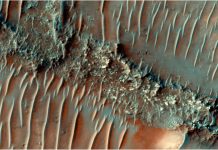
NASA has been making incredible progress in exploring Mars, not only by using rovers but also through advanced helicopters.
These helicopters are designed to fly in Mars’ unique environment, where the atmosphere is much thinner, and gravity is weaker than on Earth.
Testing on Two Worlds
For the first time, NASA is testing aircraft designs on two different planets simultaneously.
On Earth, at NASA’s Jet Propulsion Laboratory in California, engineers are experimenting with a new rotor system for future Mars helicopters.
These rotors spin at speeds close to the sound barrier, which is really fast! This is part of preparing for the next generation of Mars helicopters.
Meanwhile, on Mars, the Ingenuity Mars Helicopter, which is already there, has been breaking records for how high and fast it can fly. This helicopter was originally meant to fly just five times, but it has far exceeded that number, showing just how resilient it is.
The Challenges of Supersonic Speeds
One of the big challenges with making these helicopter blades is that as they spin faster and faster, they can start vibrating too much because of the air turbulence they create.
To tackle this, NASA’s engineers have developed new rotor blades made of carbon fiber. These blades are longer and stronger than those on Ingenuity and can handle near-supersonic speeds.
Where Earth Meets Mars
To test these blades, NASA uses a special facility called the 25-Foot Space Simulator. This enormous space can mimic the Martian atmosphere, allowing the engineers to test the blades in conditions similar to Mars.
During these tests, the blades were spun up to 3,500 revolutions per minute, which is much faster than what the Ingenuity blades have reached.
Ingenuity’s Martian Adventures
Back on Mars, Ingenuity has been busy too. It’s been flying at higher speeds and altitudes than ever before.
These flights are not just for fun; they provide valuable data about how helicopters can operate on Mars.
For instance, flying faster means covering more ground, but it can also confuse Ingenuity’s navigation system, which uses a camera to track surface features. To avoid this, the team has been flying Ingenuity at higher altitudes.
All of this work with helicopters is crucial for future Mars missions. The data collected from Ingenuity and the tests on Earth will help design more advanced Mars helicopters.
These could be bigger and more capable, able to explore areas of Mars that rovers can’t reach.
NASA is planning even more ambitious flights for Ingenuity, testing it in different ways to gather as much information as possible. This is important because, unlike on Earth, there are no repair shops on Mars, so every flight needs to be carefully planned and executed.
In summary, NASA’s work with Mars helicopters is a remarkable step in space exploration. By testing these advanced designs on both Earth and Mars, they are opening up new possibilities for studying the Red Planet in ways we never thought possible.
This exciting work is bringing us closer to understanding Mars and potentially paving the way for human exploration in the future.
Source:NASA .



